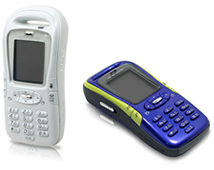 Cellcos and handset manufacturers here are counting on the seemingly limitless Japanese craving to trade up to the trendiest and newest feature-packed cellies to push cash flow forward. Right behind the recent roll out of DoCoMo’s shiny, feature-packed 3G FOMA 901i-series comes a new line of four “Mova” (the carrier’s 2G brand) handsets targeting niche buyers. Lets take a look at these babies as each one has a distinctive feature targeting a specific, finicky, not-yet-ready-for-3G keitai shopper.
Cellcos and handset manufacturers here are counting on the seemingly limitless Japanese craving to trade up to the trendiest and newest feature-packed cellies to push cash flow forward. Right behind the recent roll out of DoCoMo’s shiny, feature-packed 3G FOMA 901i-series comes a new line of four “Mova” (the carrier’s 2G brand) handsets targeting niche buyers. Lets take a look at these babies as each one has a distinctive feature targeting a specific, finicky, not-yet-ready-for-3G keitai shopper.
Niche marketing is undeniably cost-intensive — all those handsets require development, marketing and manpower to support. If 3G is where DoCoMo wants everyone to be, why continue to innovate within the older, 2G Mova line?


 On 16 November, Dr. Brian Clark, acting president and CEO, Vodafone KK, presided at an Imperial Hotel presser announcing Vodafone Japan’s first-half results for the fiscal year ending 31 March 2005. Despite mobile operating revenue falling 2.5 percent year-on-year (to 736.8 bn yen), Clark put on a brave face and emphasized the new 3G terminal line-up, increased 3G coverage, growth in prepaid, and enhanced roaming. Nonetheless, several of his comments contrast sharply with what WWJ knows to be true about the Japan market.
On 16 November, Dr. Brian Clark, acting president and CEO, Vodafone KK, presided at an Imperial Hotel presser announcing Vodafone Japan’s first-half results for the fiscal year ending 31 March 2005. Despite mobile operating revenue falling 2.5 percent year-on-year (to 736.8 bn yen), Clark put on a brave face and emphasized the new 3G terminal line-up, increased 3G coverage, growth in prepaid, and enhanced roaming. Nonetheless, several of his comments contrast sharply with what WWJ knows to be true about the Japan market. Cellcos and handset manufacturers here are counting on the seemingly limitless Japanese craving to trade up to the trendiest and newest feature-packed cellies to push cash flow forward. Right behind the recent roll out of DoCoMo’s shiny, feature-packed 3G FOMA 901i-series comes a new line of four “Mova” (the carrier’s 2G brand) handsets targeting niche buyers. Lets take a look at these babies as each one has a distinctive feature targeting a specific, finicky, not-yet-ready-for-3G keitai shopper.
Cellcos and handset manufacturers here are counting on the seemingly limitless Japanese craving to trade up to the trendiest and newest feature-packed cellies to push cash flow forward. Right behind the recent roll out of DoCoMo’s shiny, feature-packed 3G FOMA 901i-series comes a new line of four “Mova” (the carrier’s 2G brand) handsets targeting niche buyers. Lets take a look at these babies as each one has a distinctive feature targeting a specific, finicky, not-yet-ready-for-3G keitai shopper.